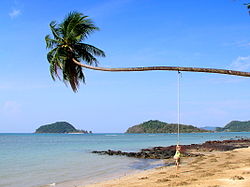Trat province
|
Trat ตราด |
||
|---|---|---|
| Province | ||
 |
||
|
||
 Map of Thailand highlighting Trat Province |
||
| Coordinates: 12°24′N 102°31′E / 12.400°N 102.517°ECoordinates: 12°24′N 102°31′E / 12.400°N 102.517°Ecenter of province | ||
| Country |
|
|
| Capital | Trat town | |
| Government | ||
| • Governor | Channa Ieamsang (since October 2015) | |
| Area | ||
| • Total | 2,819.0 km2 (1,088.4 sq mi) | |
| Area rank | Ranked 61st | |
| Population (2014) | ||
| • Total | 224,730 | |
| • Rank | Ranked 73rd | |
| • Density rank | Ranked 54th | |
| Time zone | ICT (UTC+7) | |
| ISO 3166 code | TH-23 | |
Trat (Thai: ตราด, pronounced [tràːt]) is the easternmost province (changwat) along the Thai coast. It has borders with Chanthaburi Province to the northwest, Cambodia to the east, and the Gulf of Thailand to the south. Trat is 315 km from Bangkok.
Trat is most famous for gemstone mining and trading.
The history of Trat can be traced back to the early 17th century during the reign of King Prasat Thong of the Ayutthaya Kingdom. Formerly known as Mueang Thung Yai, Trat has played an important role in the development of the country’s stability and economy due to its strategic location. The town of Trat later become a community of Chinese merchants.
After the fall of Ayutthaya to the Burmese in 1767, Trat served as a checkpoint and buffer city and was responsible for providing provisions to King Taksin the Great before he moved his forces from Chanthaburi to Ayutthaya. King Taksin then succeeded in driving out the Burmese invaders and liberated the kingdom from foreign rule.
In the Rattanakosin era, during the 1893 Paknam crisis, French troops landed and occupied the western part of Chantaburi Province. In 1904, Siam was forced to surrender Trat to French Indochina in order to regain Chantaburi. Three years later, however, finding that Trat with its almost entirely Thai population was hard to rule, the French returned Trat to Thailand on 23 March 1907, in exchange for larger areas along the Mekong river, which included Battambang, Siam Nakhon, and Sisophon, which all have a Khmer majority population.
...
Wikipedia

